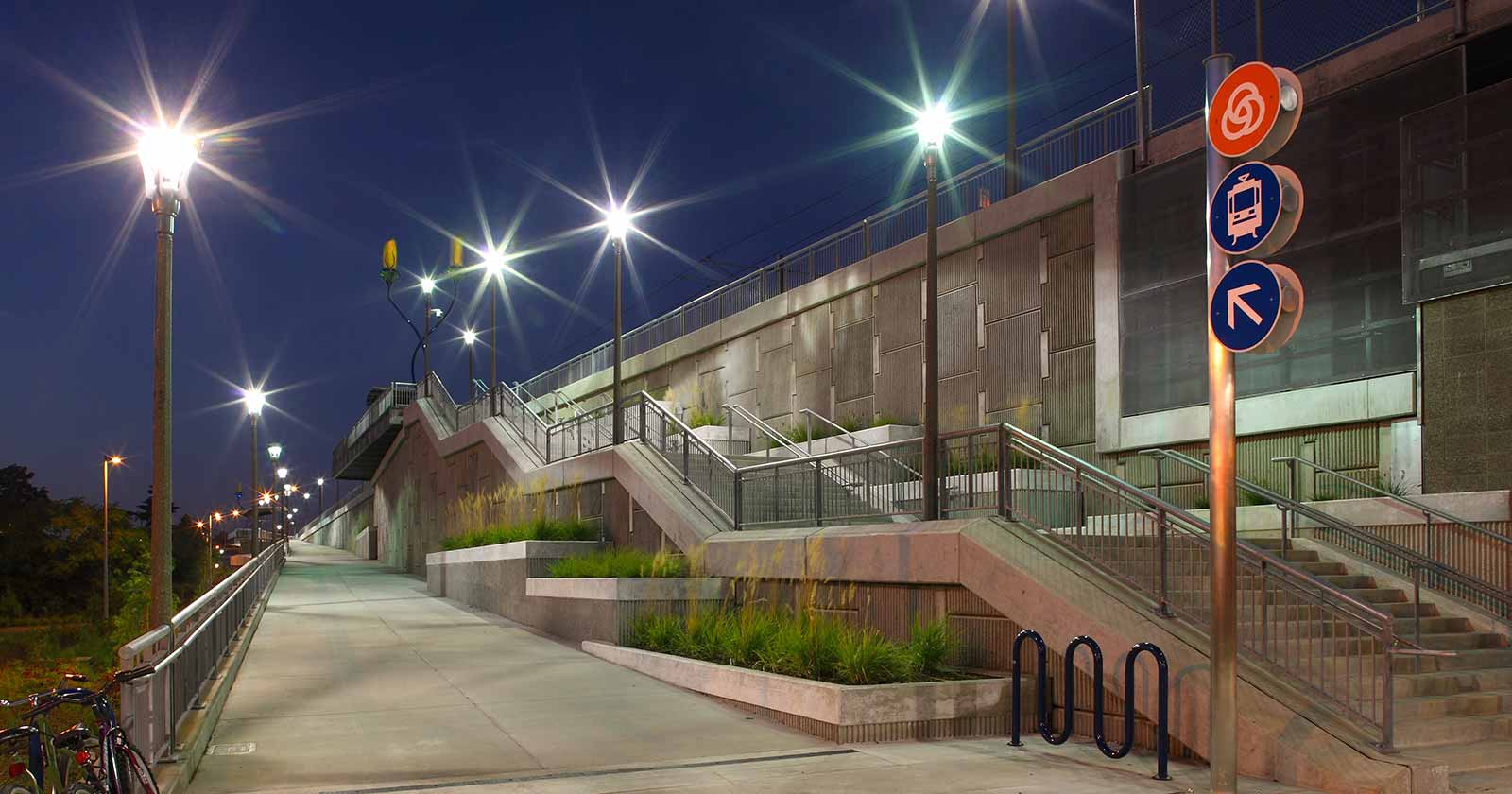
Public Art on MAX Green Line
Public art helps create a sense of place and adds to the quality of life for the citizens of our region. TriMet continued its commitment to public art on the MAX Green Line, working in collaboration with project partners and communities along the alignment.
MAX Green Line is comprised of two distinct segments — the Portland Mall and I-205 — each of which had its own customized art program. Together there were 22 artists who created over 100 separate elements.
Portland Mall
Public art was a key component in the revitalization of the downtown Portland Transit Mall. Most of the 12 sculptures created in 1977 for the original transit mall were refurbished and resited together with new sculptures by 14 significant Northwest contemporary sculptors.
The artwork follows a natural division of the downtown into three parts: North Mall — between NW Irving and Burnside, Central Mall — between Burnside and SW Jefferson, and South Mall — between SW Jefferson and College.
North Mall
Artists developed artwork with a sense of history for Old Town/Chinatown where a growing arts community has taken root.
Christine Bourdette, Cairns, 2008
Silver ledgestone
Five sculptures that mark the path to MAX stations near Glisan were inspired by the man-made stacks of stones that have traditionally served as landmarks for navigation.
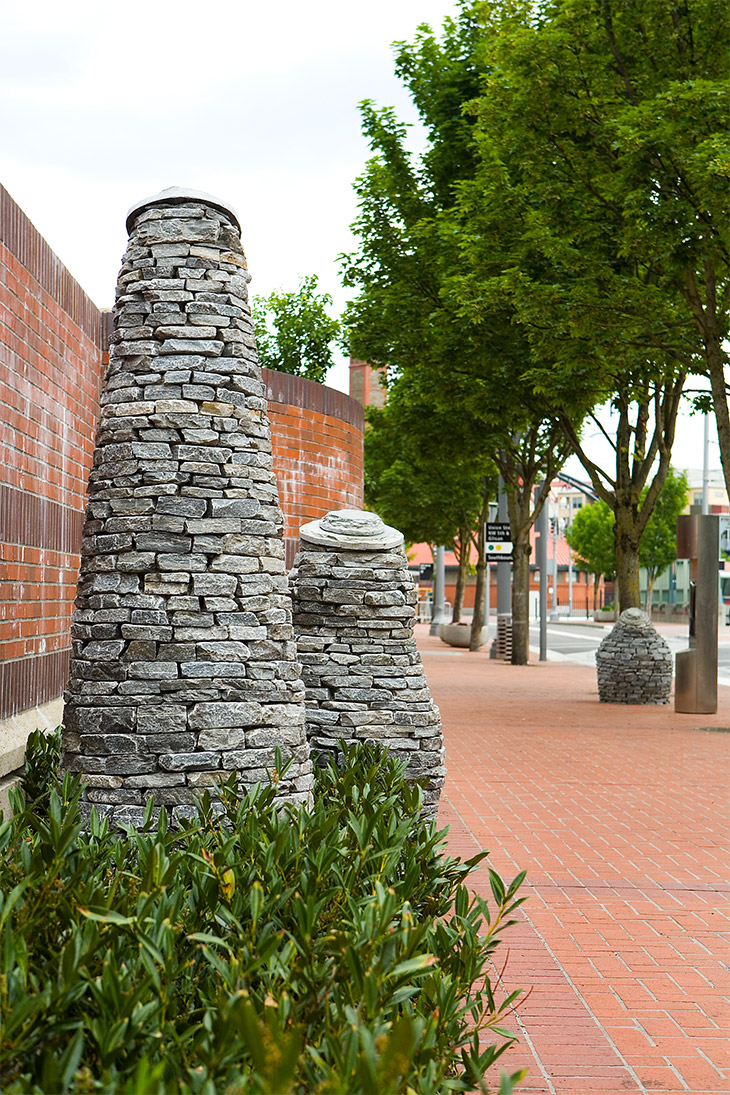 On 5th and 6th avenues, between Hoyt and Glisan streets, and on NW Irving Street at Union Station
On 5th and 6th avenues, between Hoyt and Glisan streets, and on NW Irving Street at Union Station
“I am Christine Bourdette and my work is titled Cairns.
My inspiration for Cairns came from the man-made stacks of stones that have historically served as landmarks for navigation, memorials, rituals and commemorative markers. All over the world,travelers on cross-country hiking trails traditionally add stones to cairns as they pass, often resulting in animated and sometimes precarious stacks of rocks and pebbles. This evidence of our comings and goings, often in rather comical human form, signify safety and reassurance in the wilderness.In the urban wilderness, finding one’s way through the various stages of hurry-up-and-wait is just as significant.
I am fascinated with all the ways my fellow citizens and I learn how to navigate our surroundings. My specific intention for these stacked stone forms was both to mark the path to the light-rail stations as well as to celebrate points of arrival and departure.”
Daniel Duford, The Legend of the Green Man of Portland, 2009
Bronze, cast concrete, porcelain enamel on steel
Two landmark sculptures and a series of eight “story markers” along NW 5th and NW 6th draw on the history of Portland to spin a local tale of the legendary Green Man.
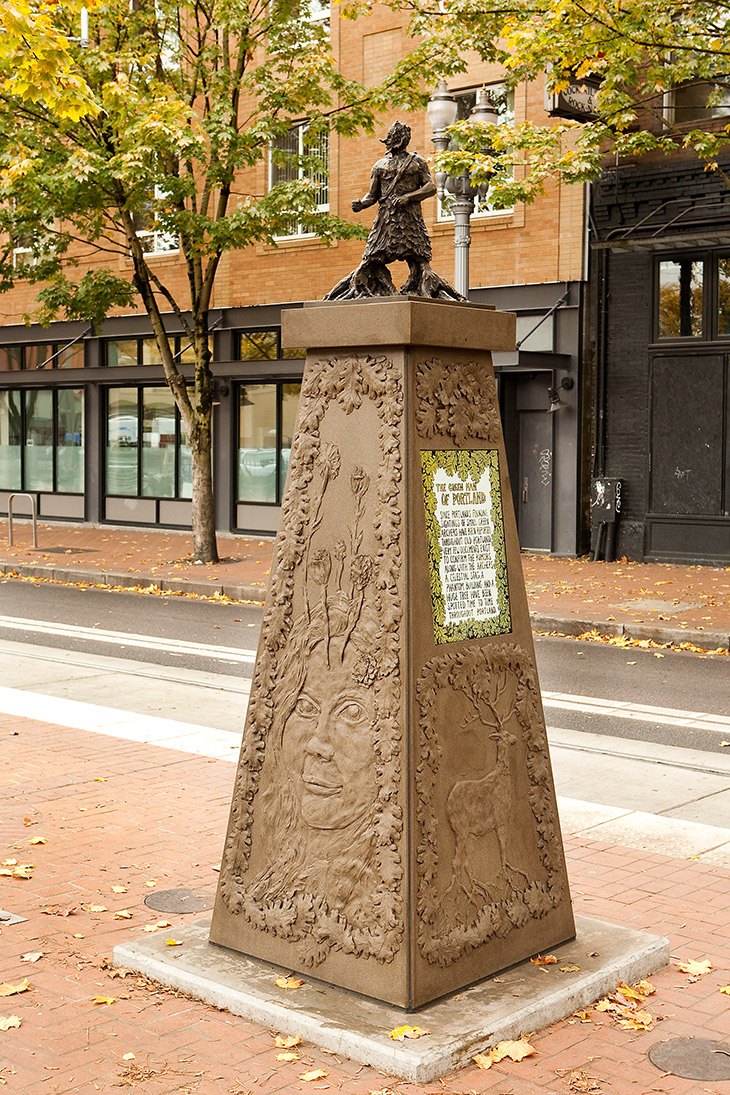 On 5th and 6th avenues, between Glisan and Burnside streets
On 5th and 6th avenues, between Glisan and Burnside streets
“I am Daniel Duford and my work is titled The Green Man of Portland.
With The Green Man of Portland, I have created a fake legend. It goes like this: ever since Portland’s founding there have been sightings of small green archers. Whenever the archer hits someone with an arrow, her vision changes. Flowers grow from the heads of passersby, a building called The Greenwood appears, and a giant tree towers over the city. On certain nights, a great white celestial stag is spied in the skies over Portland.
The piece consists of two sculptures and eight “story markers,” told as a poem over ten blocks of Old Town and Chinatown. The images in the panels combine the visual language of seventies horror comics and WPA posters. Pedestrians and riders come upon the story in fragments, depending on their routes through the neighborhood.
The legend encompasses all the varied, transitory communities that call Old Town and Chinatown home. My great hope for this piece is that The Green Man of Portland will quietly twine itself into the fabric and many-layered history of the community.”
Central Mall
Ten new works were added to the existing collection of sculptures along the transit mall to create a more comprehensive display of regional sculpture in the heart of downtown Portland.
Rick Bartow, The Responsibility of Raising a Child, 2004, cast 2009
Bronze
Traditional Native American symbols representing parenting and life cycles are woven throughout this complex piece.
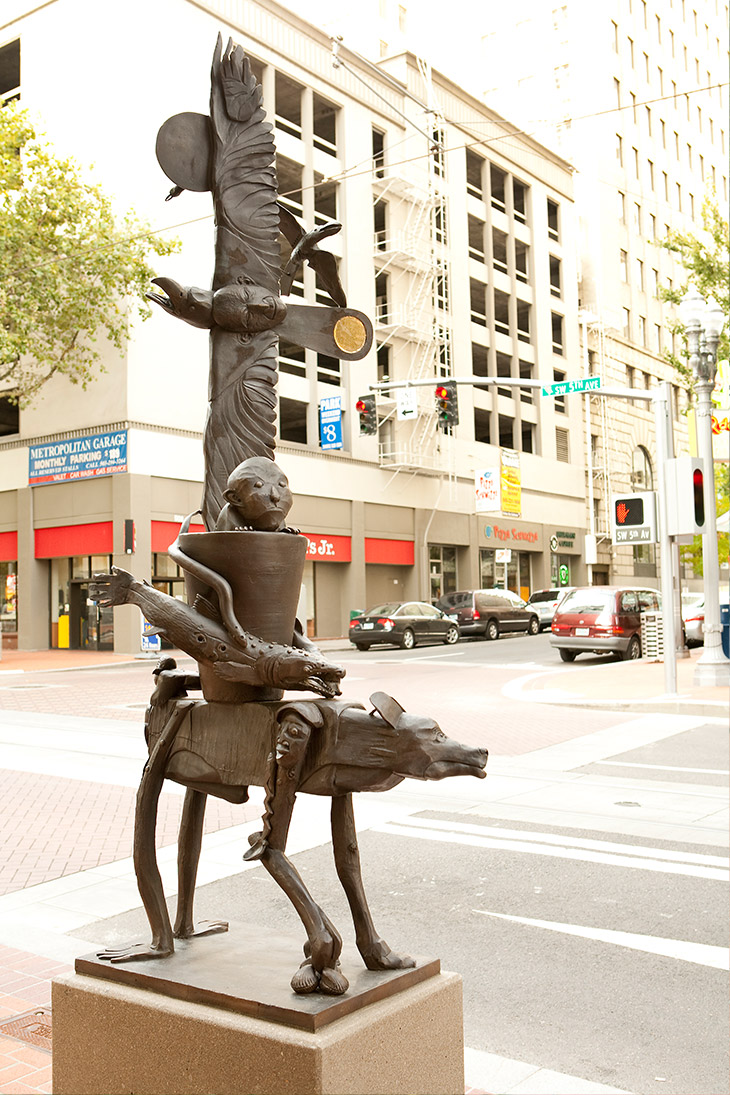 On 5th Avenue, between Yamhill and Taylor Streets
On 5th Avenue, between Yamhill and Taylor Streets
“Rick Bartow weaves symbols of parenting and life cycles throughout his work, The Responsibility of Raising a Child. At the center of the sculpture is the Native American trickster—coyote—representing life that is out of balance. On the back of the coyote is the Grandmother’s mask. In many tribal communities, the matriarchs are the doctors who put lives back in balance.
Above the Grandmother’s mask sits a coastal bird, the Killdeer. This legendary mothering bird distracts predators approaching the nest by acting wounded and hobbling away.
Representing the struggles of parenthood, a pair of salmon circle a burden basket. Salmon endure great hardships and eventually give up their own lives to have children. A lamprey eel feeds on the male salmon, showing us the naturally occurring interdependence of species.
Peering out of the burden basket is a smiling infant modeled after the artist’s daughter, Lily. The sculpture started out expressing the difficult circumstances and troubled life of single parents, often grandparents stepping in to raise a child. But when Bartow placed Lily in the basket it became a hopeful, encouraging and optimistic work.”
Chris Bruch, Whistlestop for an Organ Teacher, 2009
Stainless steel
Inspired by the large pipe organs the artist’s mother played, this work also refers to the “whistlestop” of an earlier era when politicians campaigned from trains.
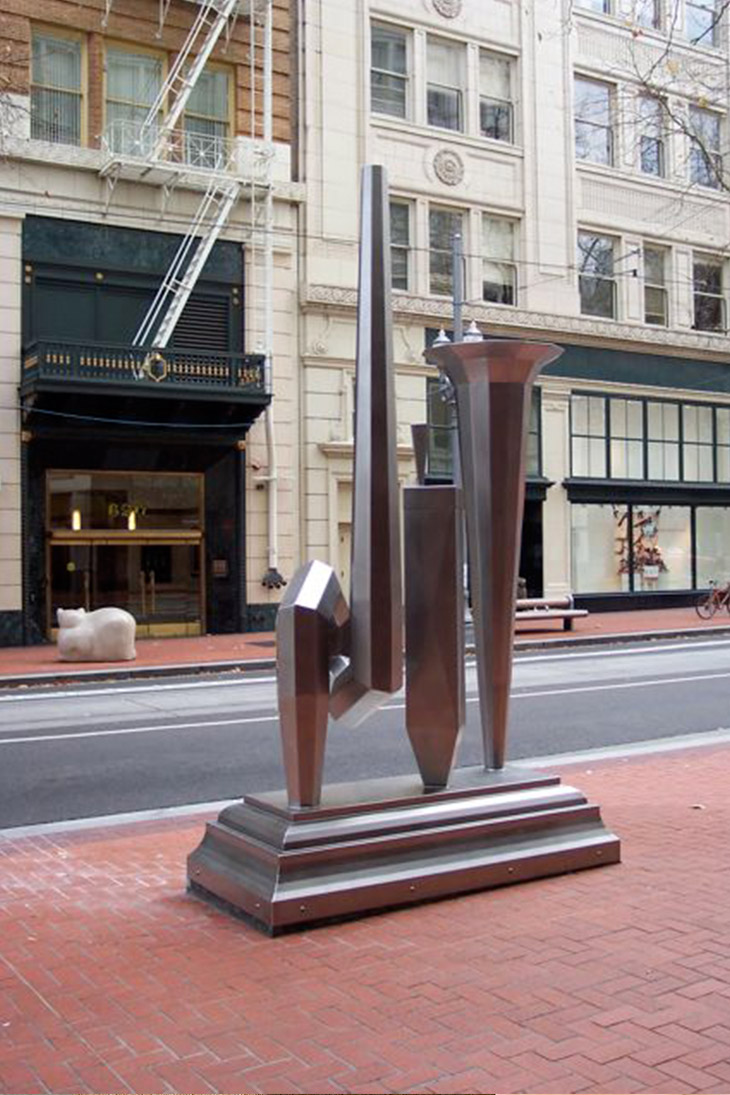 On 5th Avenue, between Alder and Morrison streets
On 5th Avenue, between Alder and Morrison streets
“Whistlestop for an Organ Teacher, by Cris Bruch, was designed to be a small island of stillness amidst the urban hubbub and dissonance of the downtown transit mall. The stainless steel sculpture is large enough to hold its place in a public setting, yet approachable and human scale.
Bruch’s mother was an accomplished organist and teacher, and he grew up spending a lot of time around large pipe organs. He always found these hand-built instruments to be remarkable and fascinating, especially the mechanical action organs. While most people appreciate the sound of the instrument and the casework, he is drawn to the processes that go into the construction of the organ.
The title has a number of references. The word “whistlestop” refers to an earlier era when politicians campaigned from trains, taking their messages to small-town, far-flung constituencies. “Stop,” in organ terminology, means a rank of pipes that all speak with a similar voice.
Although the sculpture is silent, it makes a direct reference to sound.”
John Buck, Lodge Grass, 2000
Bronze
A thistle and an abstract shape suggesting a teepee reflected in water are substituted for a figure’s head and shoulders to symbolize change in the historic west.
 On 6th Avenue, between Oak and Stark streets
On 6th Avenue, between Oak and Stark streets
“The title of John Buck’s sculpture, Lodge Grass, refers to a town in Big Horn County, Montana, that was originally settled by Native Americans. Lodge grass is also the name for a range of plants used by indigenous peoples to make shelters. As the environment has evolved and useful plants such as lodge grass have disappeared, the thistle and other noxious weeds have replaced them, in the same way that wilderness areas have been replaced by suburban developments.
In this sculpture the artist has substituted symbols and imagery for the figure’s head and shoulders. One form is an abstract shape suggesting a teepee reflected in water. The other more dominant form is that of a thistle, the first plant to pop back up after you’ve cleared the land.
In making Lodge Grass Buck whittled and chiseled the figure from laminated wood, and then cast it in bronze. The greenish patina is the natural color of bronze after it has weathered over a long period of time.”
Mark Calderon, Floribunda, 1998
Bronze
This is one of a series of abstract works by this artist inspired by the hairstyles found in Japanese Buddhist sculpture of the twelfth and thirteenth centuries.
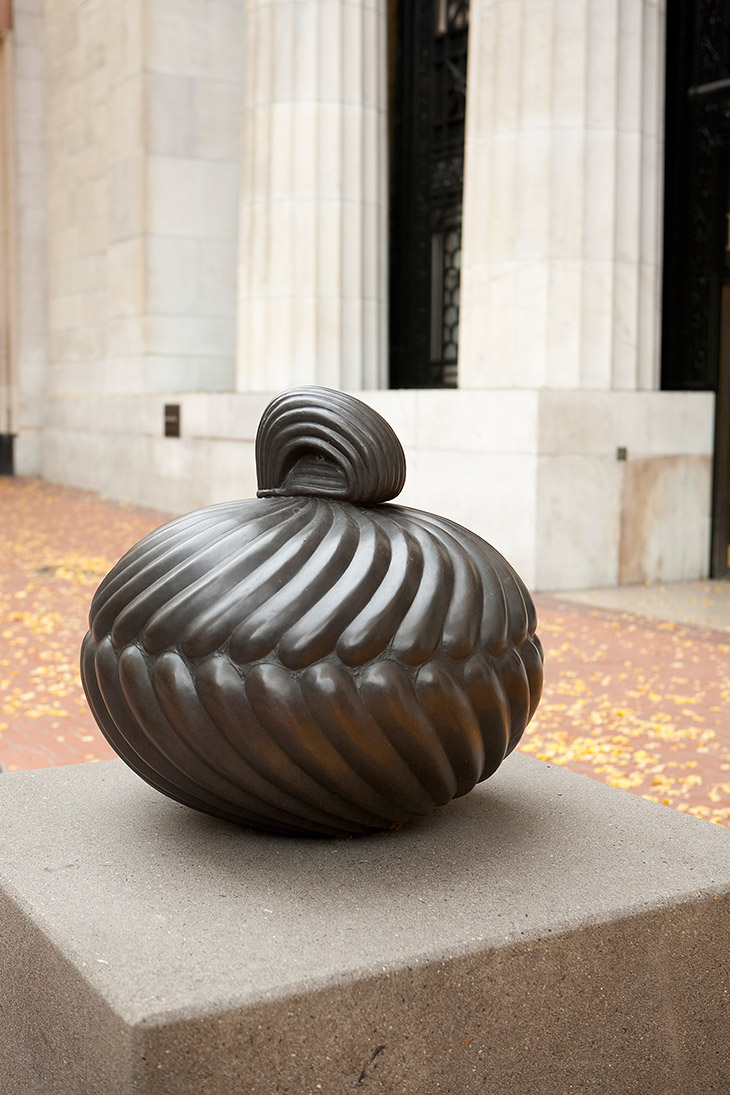 On 5th Avenue, between Stark and Washington streets
On 5th Avenue, between Stark and Washington streets
“Floribunda, by Mark Calderon, is one of a series of works the artist made in the late nineties inspired by the hairstyles found in Japanese Buddhist sculpture in the twelfth and thirteenth centuries. Much of his work from that period was inspired by religious images of ancient cultures and consisted of larger than life-size pieces—head-like in form—meant to be displayed on a wall.
Floribunda is the only free-standing work from this series. It is comprised of two hemispheres that come together into one form. Repeated ribs rise from the base and expand as they twist in a clockwise direction. They end at the midline to meet the upper ribs, which rotate in a counter-clockwise direction and culminate in a plume-like topknot. The design and pattern of the hairstyle envelops the entire form, creating a finished work that is quite abstract.”
Bruce Conkle, Burls will be Burls, 2009
Bronze and cast concrete
This three-part work is a tribute to snowmen, the proverbial “canary in the coal mine” for climate change, and to the forests of the Pacific Northwest.
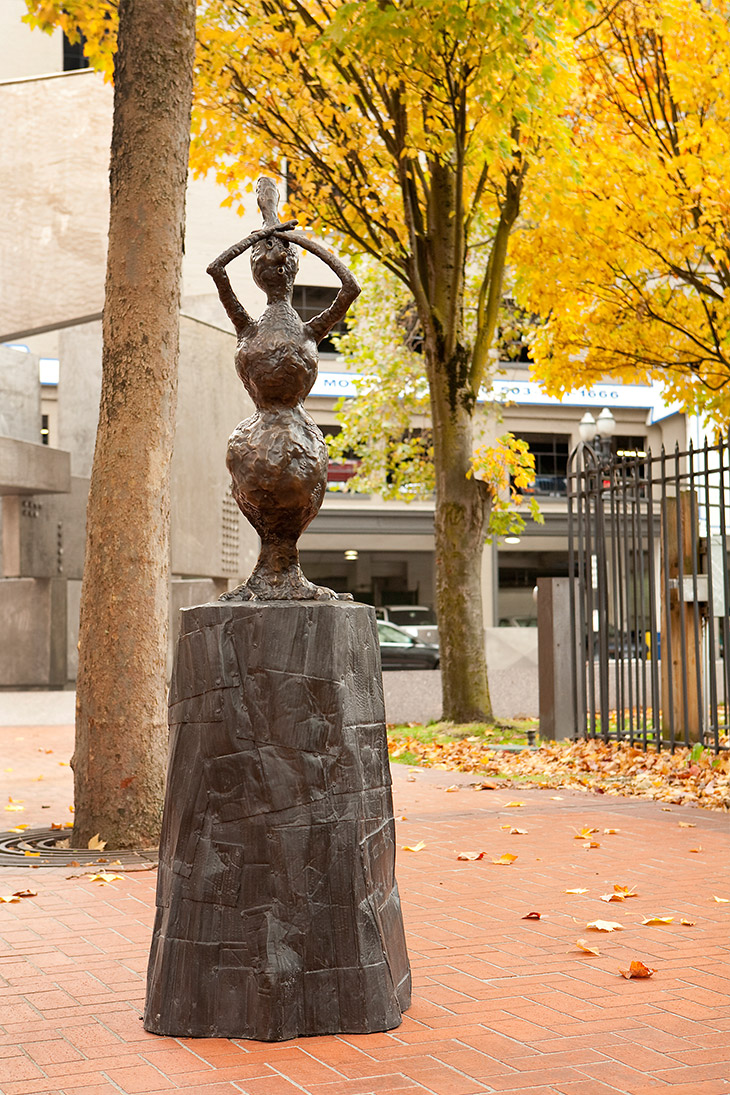 On 6th Avenue, between Burnside and Ash streets
On 6th Avenue, between Burnside and Ash streets
“Burls Will be Burls, by Bruce Conkle, is a tribute to snowmen and to the forests of the Pacific Northwest. Conkle considers snowmen the proverbial “canary in the coal mine” for climate change, as they will not withstand warming of more than a few degrees, and must evolve to survive changing conditions.
The cast bronze figures of Burls Will be Burls represent what might happen when a snowman melts and nourishes a nearby living tree. Water is absorbed by the roots and carries the spirit of the melted snowman up into the tree where it manifests itself as burls. By using recycled cardboard to model the bases, the artist creates monuments to the prior life of the trees before they are cut down and turned into paper products.
One of the burl figures contemplates a column of precariously stacked snowballs, looking back to his frozen watery past while contemplating his future. This columnar formation of spheres—thought of as an “Endless Snowman”is a riff on “Endless Column,” by Constantin Brancusi. The far figure, closer to Pine Street, strains to see the other works, attempting to focus on both the column and her own burl kin.”
Chris Gander, Puzzle Tower 1, 2007
Stainless steel
Five basic geometric forms are combined in an exploration of symmetry and visual balance.
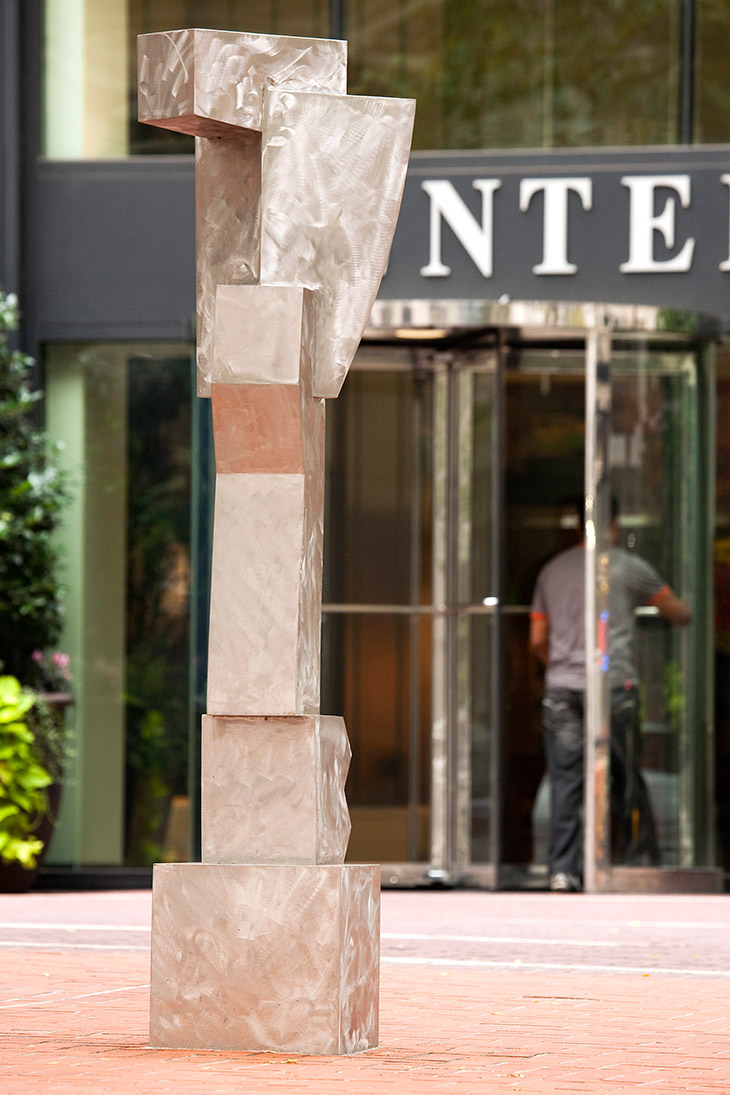 On 5th Avenue, between Salmon and Main streets
On 5th Avenue, between Salmon and Main streets
“Puzzle Tower, by Chris Gander, consists of five basic geometric forms designed as an exploration of symmetry, visual balance and the creation of something familiar out of something unknown or new. The artist intentionally kept these forms basic and slightly vague in origin; they can be thought of as structural or architectural.
The act of combining these forms in new, perhaps unexpected, ways presented interesting problems to Gander as an object maker. He equates the act of solving these problems to basic human tendencies: searching for meaning, significance and understanding.
Just as puzzles rely on clues and speculations for their resolutions, Puzzle Tower invites viewers to make connections—to speculate and find meaningful personal references from something unknown or unfamiliar. It’s the artist’s hope they will equate this experience to the act of thinking and resolving.”
Malia Jensen, Pile, 2009
Bronze
A stack of animals and objects is an homage to the tougher, grittier Portland the artist knew in her youth.
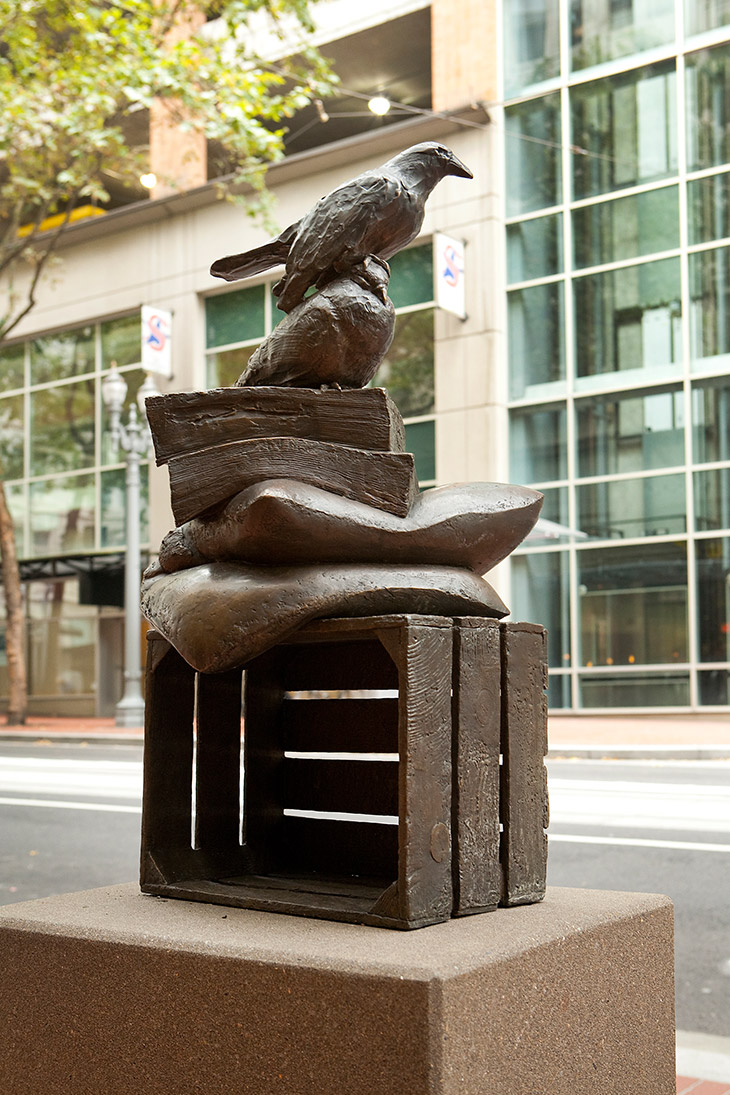 On 6th Avenue, between Washington and Alder streets
On 6th Avenue, between Washington and Alder streets
“My name is Malia Jensen and my piece is called Pile.
Much of my work involves animals and objects combined into situations suggesting a narrative or a parable. I think of Pile as homage to the Portland I knew as a kid, a tougher, grittier Portland.I think of it as a kind of totem of portraits that can be arrayed in the mind into various stories.
The crate as a base represents Oregon’s agricultural foundation and its tradition of hands-on work. The pillow is a stand-in for home, wherever one finds it. The phonebooks mark my affection for the tactile aspect of information and searching, a relic of another era as we rely increasingly on electronic media.
Pigeons and crows are urban birds, traveling between a paved-over city environment and an airborne wilderness that hints at what has been lost. The pigeon has a patient forbearance while the more ambitious, perhaps imperious, crow seems to consider how or where to go next.
Even as you find your way—to a bus or to your future—it’s useful to consider where you’ve been.”
Mel Katz, Daddy Long Legs, 2006
Painted aluminum
Combining elements of sculpture and painting, this work was influenced by the pattern pieces the artist’s father cut as a tailor.
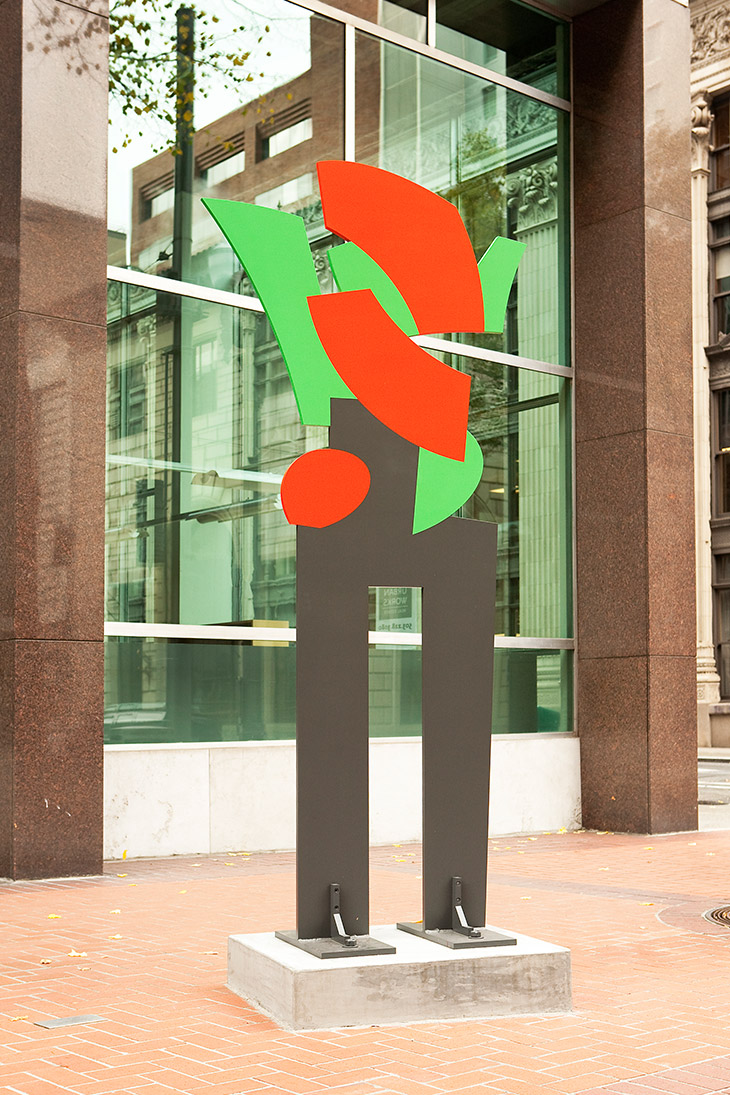 On 6th Avenue, between Stark and Washington streets
On 6th Avenue, between Stark and Washington streets
“In Daddy Long Legs, Mel Katz combines elements of sculpture and painting to create a counterpoint and contrast that add to the complexity of the work. The artist’s father was a tailor, and growing up he was influenced by watching him work with templates to cut pattern pieces.
Katz began his career as a painter, but after turning to sculpture discovered he could create shapes with colors. When he used paint onhis materials, whether wood, plastic or cast concrete, the variations brought him back to where he hadstarted as a painter.
This free-standing aluminum sculpture maintains a flat surface but the painted interior shapes that overlap and interlock give the illusion of dimension. To Katz, this is a painting issue. The lower half of the sculpture, with its elongated black shapes and welded base plates, suggest pant legs. This became his reason for naming it Daddy Long Legs.”
Patti Warashina, City Reflections, 2009
Bronze and granite
Stylized versions of a strong female figure and her canine companion observe the life of a busy urban walkway.
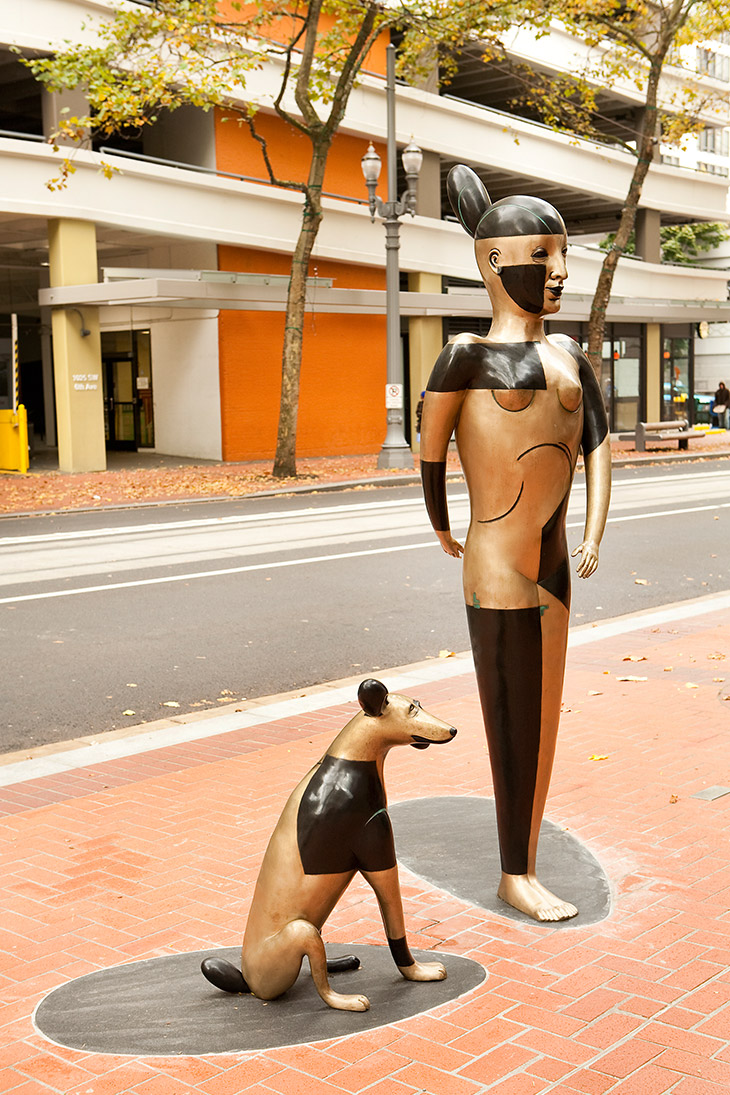 On 6th Avenue, between Salmon and Main streets
On 6th Avenue, between Salmon and Main streets
“ In conceiving City Reflections, Patti Warashina thought about life on an urban public walkway. The transit mall between Salmon and Main, where her two bronze sculptures are located, is in the heart of Portland where business, civics and culture all come together.
The standing figure is a stylized version of a strong female in both a classical and minimal form. The watching dog acts as a counterbalance to the female figure and is the friendly canine companion that is so much a part of our popular culture.
Black geometric shapes on the bronze sculptures reference elements of the human body and reflect the shapes and shadows of the surrounding buildings. The black shadows on the sidewalk serve as a natural transition to the pedestrians on the street, as well as indicating the time of day.
The smaller copper shapes scattered on the surface of the figures represent computer-generated forms, which speak to the times we live in.”
Mark R. Smith, Reading the Street, 2008
Enameled and laminated glass, stainless steel
A series of eight, laminated-glass panels feature hundreds of silhouetted figures culled from newspapers and representing a wide variety of people, cultures and social behaviors.
 On 5th Avenue, between Oak and Stark streets
On 5th Avenue, between Oak and Stark streets
“I am Mark R. Smith and my work is titled Reading the Street.
Reading the Street consists of a series of eight glass panels with images of silhouetted figures arranged in horizontal rows. Through body language and gestures, the images are meant to be read and deciphered like text, as the work addresses the complicated nature of human interaction in crowded urban thoroughfares. As people cross paths with one another, encounters can be intimate and anonymous at the same time. Those encounters are also multilayered and flavored by each individual’s perception of archetypes: the streetvendor, the disabled vet, the corporate VP, the student activist or the sports fan.
Through visual transparencies and overlays of images, I was attempting to obscure any clear reading of an individual’s appearance or behavior. Changes in light and atmosphere affect the translucent surfaces of the glass panels. Under direct lighting, the figures appear somewhat stationary and fixed. When the panels are backlit, the figures appear to be in flux. In other words, people are not always what they appear to be.”
South Mall
The artwork for the progressive university district expresses the theme of sustainability.
Fernanda D’Agostino, Urban Hydrology, 2009
Carved granite
Twelve oversized “diatoms,” microscopic organisms studied to evaluate water quality, are located in the infiltration strips adjacent to the university.
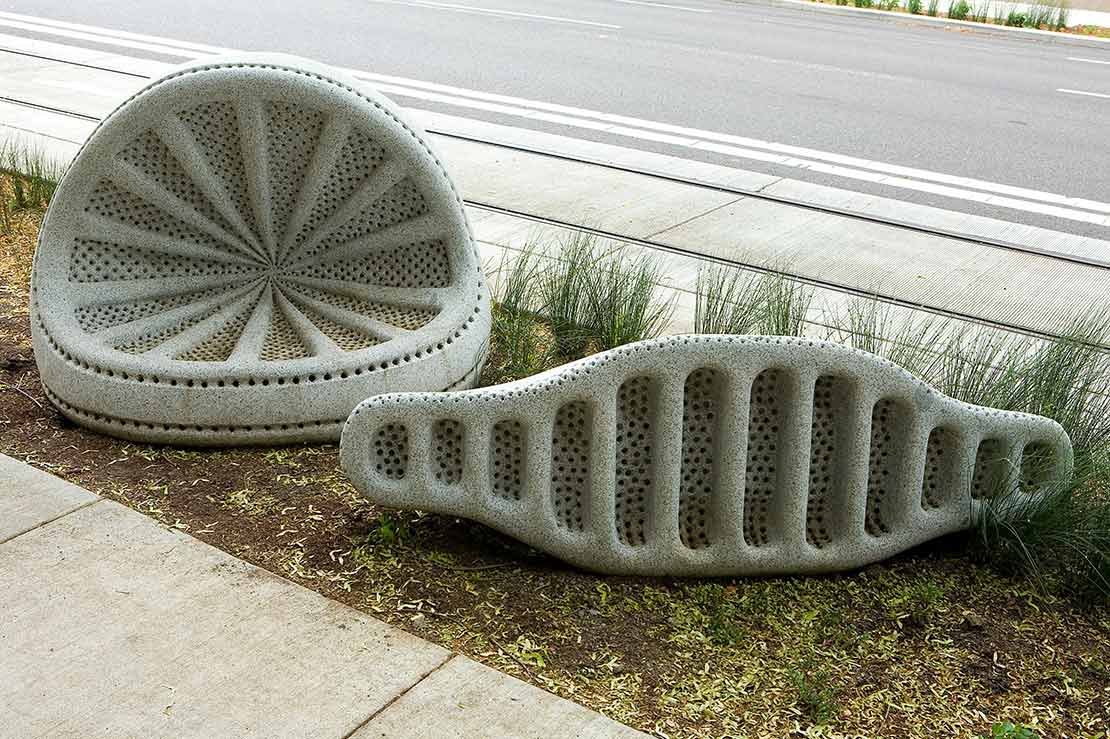 On 6th Avenue, between Mill and Hall streets
On 6th Avenue, between Mill and Hall streets
“I am Fernanda D’Agostino and my work is titled Urban Hydrology.
My concept for Urban Hydrology was to create a visually compelling urban journey that reveals some of the investigations in environmental science taking place at nearby PSU. A professor there told me that one problem humans have in addressing environmental problems is our limited ability to perceive at different scales. Many important things are simply too small or too large for us to comprehend. This made me think it would be valuable to reveal some hidden phenomenon, in particular the beautiful single-celled organisms used to evaluate water quality in urban streams.
Twelve oversized diatoms carved in granite are sited in the biofiltration strips unique to the the southern portion of the transit mall. Placing them in the water filtration strips adds a supporting layer of content to the landscape.Unbeknownst to me, the project was recently shown as part of a presentation at the North American Diatom Symposium, delighting the audience of scientists.
With Urban Hydrology, I tried to thread the needle between beauty, abstraction and content to appeal to both academic and casual viewers.”
Michihiro Kosuge, Continuation, 2009
Carved granite
Five abstract sculptures made with reused granite imply motion through their interrelationships along the streetscape.
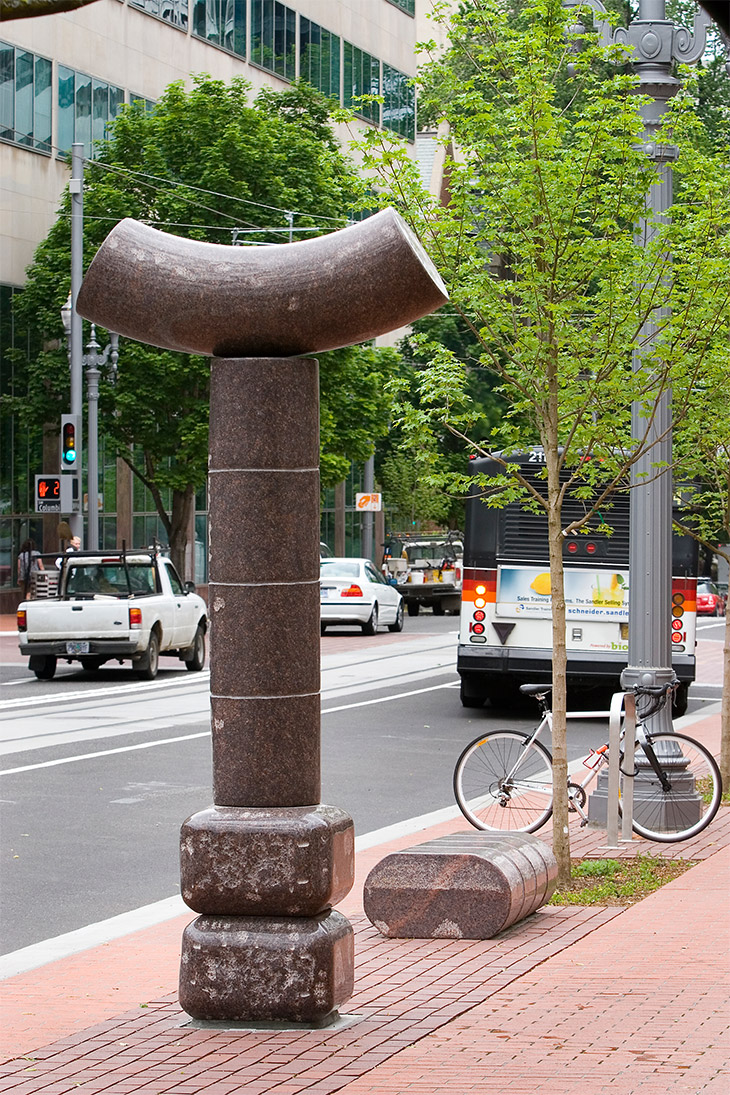 On 6th Avenue, between Columbia and Clay streets
On 6th Avenue, between Columbia and Clay streets
“ With the five sculptures that make up Continuation, Michihiro Kosuge re-used red granite from an earlier sculpture and fountain installation on the bus mall. The designated location for the work was unusual in that it encompassed the outdoor spaces of the Hotel Modera as well as the adjoining sidewalk. For the artist, the material and the site presented both opportunities and challenges. In particular, he wanted to create relationships between the multiple pieces while allowing each piece to stand on its own.
For the concept, Kosuge began by studying the stones, which were relatively small and with curved edges. Their size and shape were central in determining what the final work would look like.
The resulting five sculptures involve interconnecting visual elements that include repetition, tension and stability. Hopefully, each viewer will have a unique opportunity to enjoy the pieces from different perspectives and to understand the relationship of the sculptural shapes to one another.”
I-205
Seven artists were selected to create wayfinding sculptures for each station along the 6.5-mile light rail extension between Gateway and Clackamas Town Center. Signposts, Symbols and Settlement Stories, a report on the cultural history of the neighborhoods along the alignment, was commissioned to assist the artists as they developed concepts for their work. (See download link.)
Station shelters feature windscreen glass etched with migratory birds designed by Kim Hamblin and colored-glass tiles on the columns.
Anne Storrs, Tall and Fallen, 2009
Pigmented concrete, stainless steel
Abstract, cast-stone ginkgo leaves are stacked and interlocked to form a columnar sculpture on the platform. Individual pieces scattered in landscaping near the station entrances suggest fallen leaves
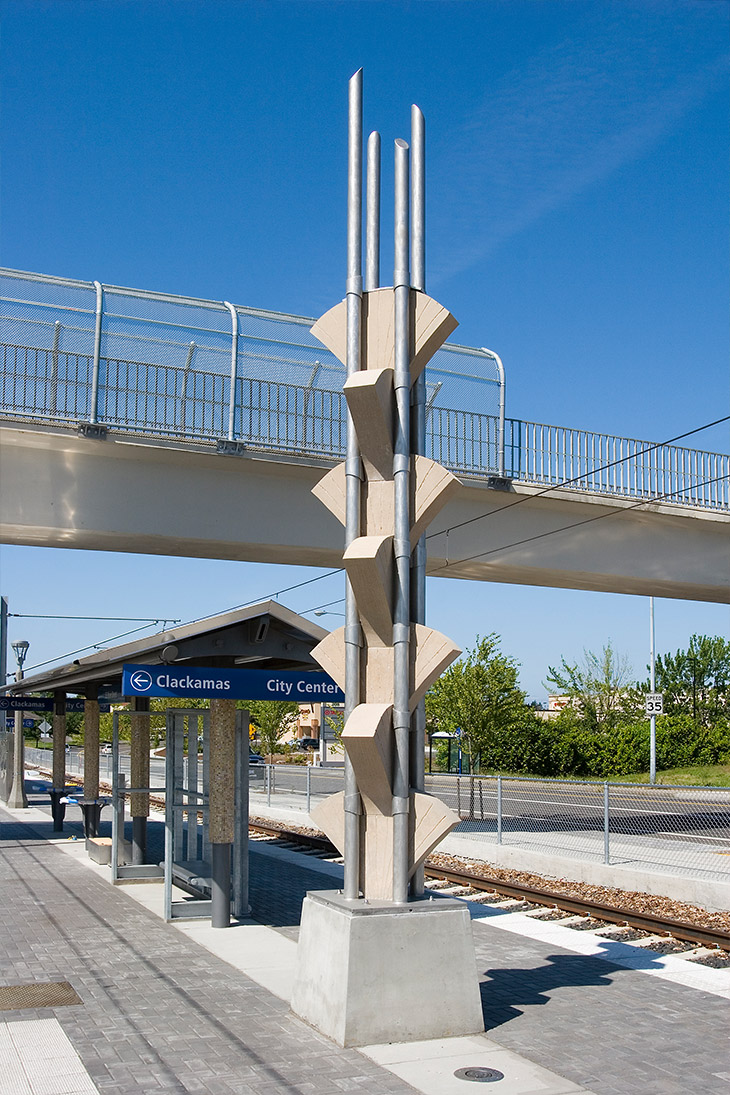 SE Main St Station
SE Main St Station
“I am Anne Storrs and my work is titled Tall and Fallen. The inspiration for Tall and Fallen came from the beautiful fan-shaped leaf of the Ginkgo biloba. A group of these trees planted around the Main Street platform reinforced my idea to make this sculpture for this station.
Tall consists of seven abstracted ginkgo leaves cast in concrete. The top of the leaf form is notched so the pieces interlock and stack inside four stainless steel poles. I like this combination of materials, and the way the piece goes together makes me think of an erector set. It also reminds me of a spinal column, or maybe an emerging plant.
Fallen, constructed with the same leaves stacked singly or in pairs, suggests the gingko trees’ fallen leaves, and is a metaphor for the ordering, scattering and reordering of people riding the train.
Some say the leaf of this ancient tree, if taken as an extract, aids the memory. So this sculpture might help you remember this is Main Street, and you might remember other things too.”
Carolyn Law, Sky to Earth, 2009
Custom-colored, vinyl-clad fencing
Sky to Earth is a sky-blue sculptural fence that undulates along the west side of the station platform area. Its flowing sculptural line is a visual metaphor for the movement of the wind.
 SE Division St Station
SE Division St Station
“ I am Carolyn Law and my work at the Division Street Station is titled Sky to Earth.
Sky to Earth is a vivid sky blue, vinyl-clad fence that rides the visual edge between the light rail tracks on one side, the I-205 freeway lanes along the other side, and the expansive topography of the surrounding land.
The fence can be viewed at many speeds and from many angles. Its flowing and changing sculptural line shifts between solid and transparent, and activates the site and the experience of riders as they use the train and the station. It is also visible to people on the freeway and in the street.
The Sky to Earth site is an intense place with a sensory undercurrent of the sky and the wind. The wind is almost a constant. Grasses ripple elegantly and hypnotically, registering the caprice of the wind’s direction from moment to moment. The artwork plays with this notion while embracing the entire station and all the riders.”
Valerie Otani, Money Tree, 2009
Stainless steel, Plexiglas
Referencing a Han Dynasty symbol of prosperity, this sculptural tree features branch designs based on the cut-paper traditions of several cultures. At the treetop, a phoenix represents the hope for community regeneration.
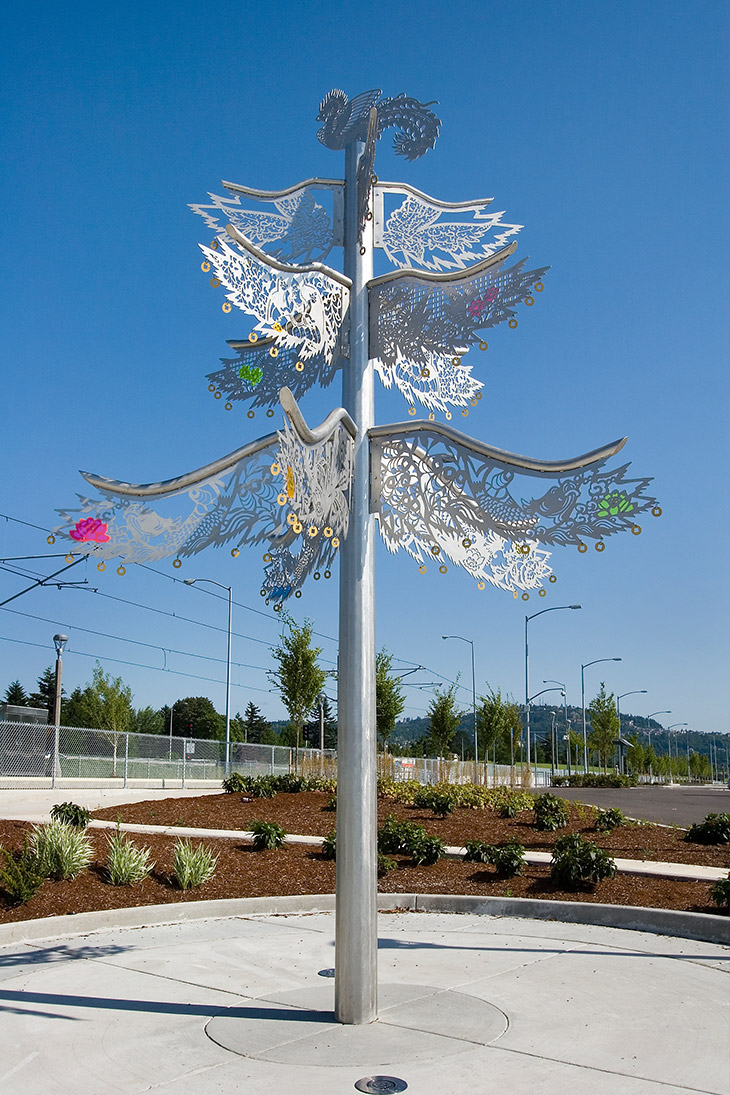 SE Powell Blvd Station
SE Powell Blvd Station
“ I am Valerie Otani and my sculpture for the Powell Blvd Station is titled Money Tree.
Money Tree was inspired by a 2000-year old bronze sculpture from the Eastern Han dynasty at the Portland Art Museum. I loved its lacy form, which reminded me of the art of paper cutting. This led me to make a tree for East Portland that would symbolize the revitalization of the neighborhood and hope for the prosperity of the new immigrant communities.
The overall form of Money Tree evokes the Douglas fir, the familiar trees that once stood on this site. Each branch takes its design from the folk art of the cultures of the neighborhood. In China, a carp in combination with a lotus carries the wish for successive years of abundance. Gold coins cascade from the hand of the Indian goddess Lakshmi. A unique branch designed by Arab-American artist, Huda Totonji, uses calligraphy to form the wings of a bird. Atop it all is a phoenix, a symbol of rebirth that represents how the new light rail line contributes to the regeneration of the neighborhood.”
Suzanne Lee, Shared Vision, 2009
Stainless steel, paint, fiber optic lighting
Above the station platform, a sculpture with five ornate lanterns has designs referencing various world cultures. A celebration of community diversity, it also serves as a welcoming beacon at night.
 SE Holgate Blvd Station
SE Holgate Blvd Station
“ I am Suzanne Lee and my sculpture is titled Shared Vision.
Lanterns are popular festival decorations associated with gaiety and rejoicing and they remind us of the security of a light in the window.
The lanterns at the Holgate station represent prosperity as the richness of positive social interaction and communication—the very essence of neighborhood. Embracing family, home and community, my sculpture symbolizes the revitalization of an area previously identified by low income, high crime, indifference and division. These culturally referenced lanterns “light the way,” emphasizing a sense of well-being and celebrating many voices being heard.
Light is defined as something that makes vision possible. Using light as a metaphor for expanded awareness,these lanterns reflect public knowledge, insight and joy.The shapes and patterns of these lanterns were inspired by traditional designs from Asian, Russian, European, Latin American, African, Moroccan and Native American cultures. Shared Vision stimulates both personal and communal memory, capturing past and present cultures it mirrors them back to their communities.”
Brian Borrello, Lents Hybrids, 2009
Powder-coated steel, vertical wind turbines, photovoltaic panels, light-emitting diodes
Art merges with sustainable technology in three spiraling plant-like sculptures topped with buds that are animated by the wind. The hybrid energy system alludes to the unfolding potential of the Lents neighborhood.
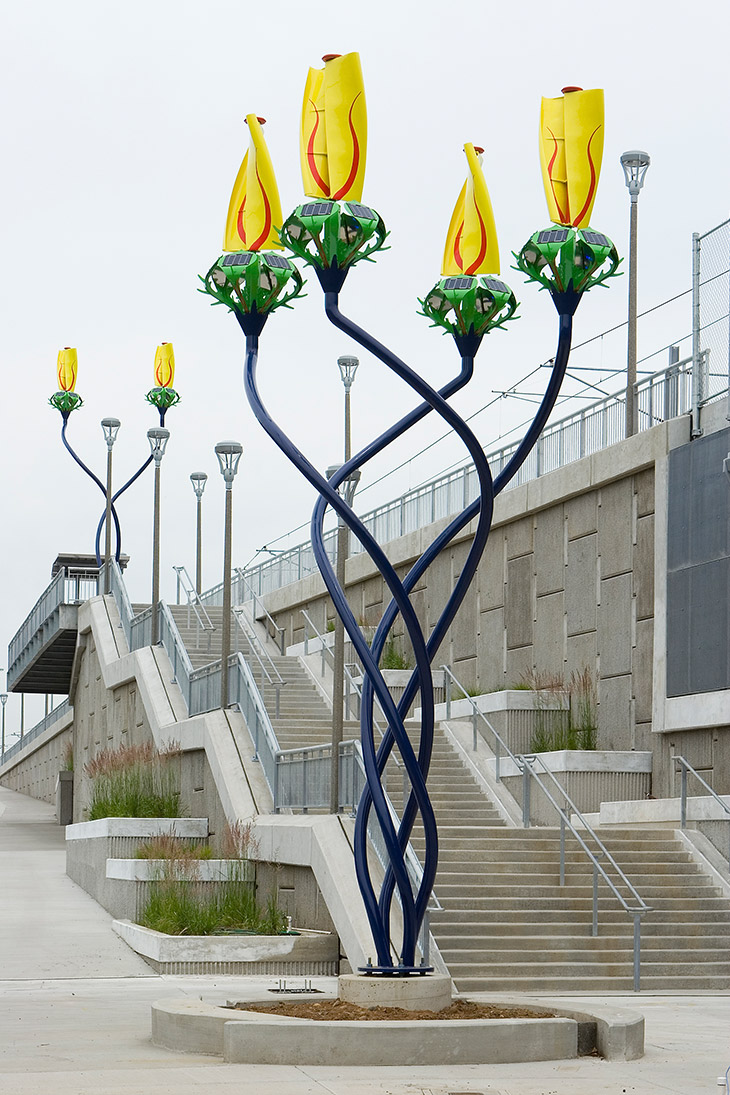 Lents Town Center/SE Foster Rd Station
Lents Town Center/SE Foster Rd Station
“ I am Brian Borrello and I have created several groupings of sculptures that I call the Lents Hybrids.
Lents Hybrids at Lents Town Center is a series of spiraling plant forms with “buds” that generate energy through a hybrid system of wind and solar generators. The plants are evocative of the long grasses that may have grown in the meadows around here; the buds are symbolic of unfolding beauty and potential for the Lents neighborhood.
I tried to make the Lents Hybrids as a wayfinding element as well; where making them tall and colorful and placing them throughout the station will help riders find their way to the platform area. They also serve as strange biomorphic entities that respond to current environmental conditions with their expression of light and movement.
The wind turbines are vertical access turbines and spin at the slightest breeze, and solar panels collect sunlight energy even on cloudy days. At night the sculptures emit blue LED lighting, which is programmed to express the range of available energy; sculptures will glow gently with an intermittent “heart beat” on low power and in times of high energy gain from a sunny or windy day they will pulse rapidly. I like to think of them as sculptures that change by day and by night. At night they come alive like wonderful night blooming flowers.”
Brian Borrello, Johnson Creek Watershed, 2008
Pigmented concrete, stainless steel
The five tributaries of the Johnson Creek watershed are represented by five stainless steel medallions set into pigmented concrete paving in the plaza area.
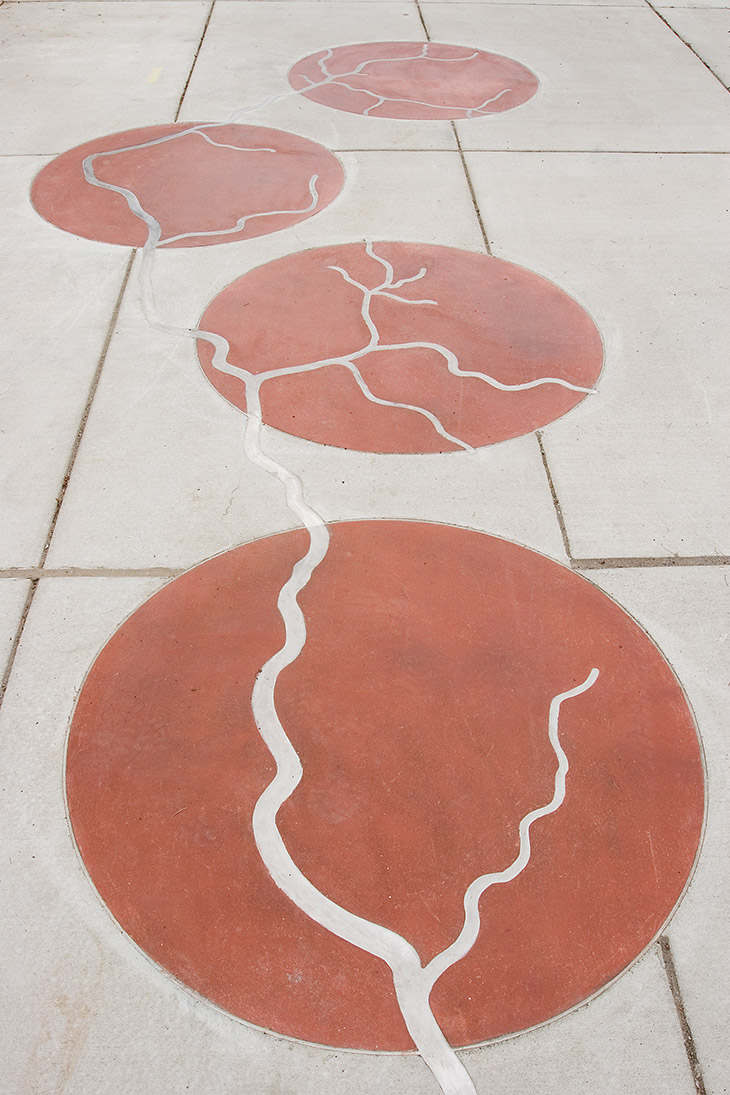 SE Flavel St Station
SE Flavel St Station
“I am Brian Borrello and I have created the Johnson Creek Watershed Map.
Maps are a way of connecting people to places, guiding them and allowing them to take a mental journey before they make the actual physical one. People find places meaningful through their memories and experiences of the space, and maps help facilitate this. With Johnson Creek Watershed Map, I wanted to remind riders, neighbors and communities in that area of their regional watershed, one of the major inland watercourses of Portland.
The five circular medallions in stainless steel and pigmented cement at the SE Flavel Station represent the five tributaries that comprise the Johnson Creek watershed. At the station, you stand only a few feet from Johnson Creek, a vital flowing body of water that is joined by other creeks—Veterans Creek, Mitchell Creek, Kelly, Butler, and Badger Creeks. All flow together into the Willamette River, which in turns flows into the Columbia and on to the ocean.
Leonardo daVinci said: “When you put your hand in a flowing stream, you touch the last that has gone before and the first of what is still to come.”
Pete Beeman, Waving Post, 2009
Stainless steel, powder-coated steel and aluminum
This tall, kinetic sculpture invites interaction with a crank at its base that can be turned to wave its wing-like structures, and gesture across Interstate 205.
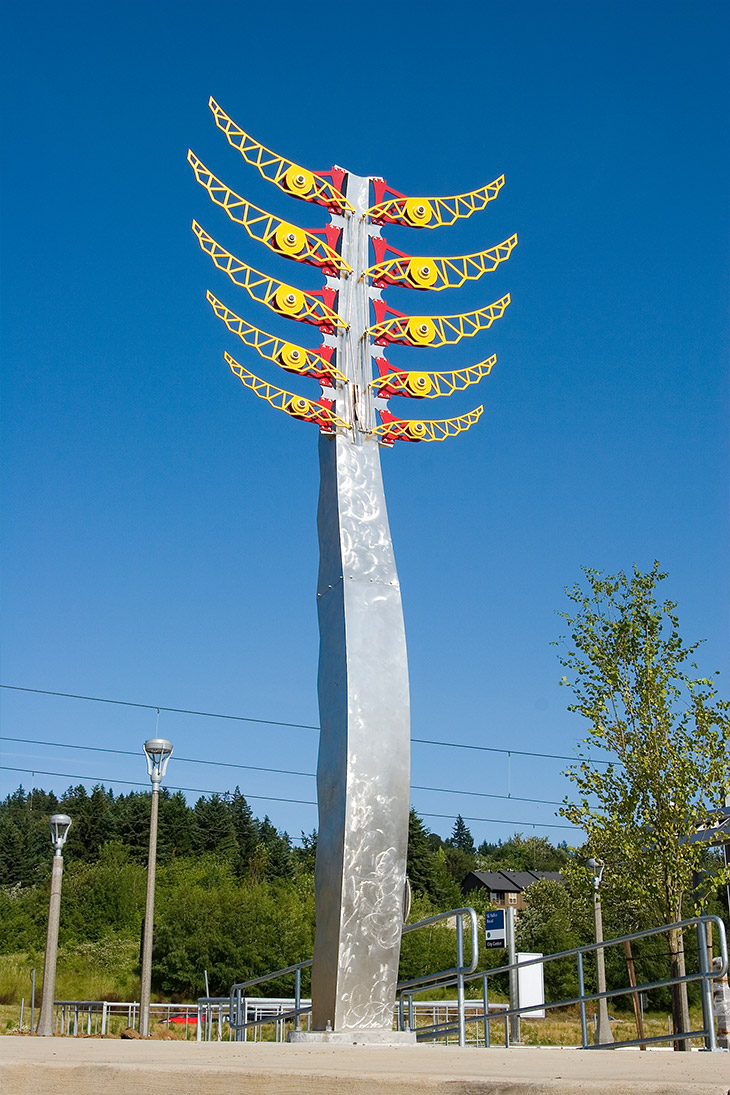 SE Fuller Rd Station
SE Fuller Rd Station
“I am Pete Beeman and my work, a stainless steel and aluminum sculpture at Fuller Road station, is called Waving Post.
The forms of Waving Post are visually suggestive without being too explicit. When I designed the yellow and red horizontal elements, I wanted them to suggest different things to different viewers. One person might come to it and see a human spine; another might see a dinosaur bone, bird wings or even a building truss.
The Fuller Road station is located in an old neighborhood named for an Oregon Trail family. When the freeway went in, the neighborhood was bisected and mostly eliminated. When I realized that a one-block piece of Con Battin Road continued on the other side of I-205, I wanted to make a sculpture that could wave hello at that distant piece of street across the way.
It is important to me that public art be engaging. Waving Post invites viewers to turn the crank, bring the sculpture to life, and wave to the neighbors.”
Richard C. Elliot, The Chain of Life, 2008
Twisted Ribbon
Acrylic reflectors, Plexiglas
A 27' high vertical band of brightly colored reflectors in the glass of the elevator at the Transit Center suggests woven beadwork or a ribbon-like strand of DNA.
Pioneer Quilts
Galvanized steel, platform pavers
Pioneer quilt patterns appear in 40 cut-metal panels in the guardrails at the Transit Center. Patterned brickwork on the station platform is based on traditional Clackamas basketry.
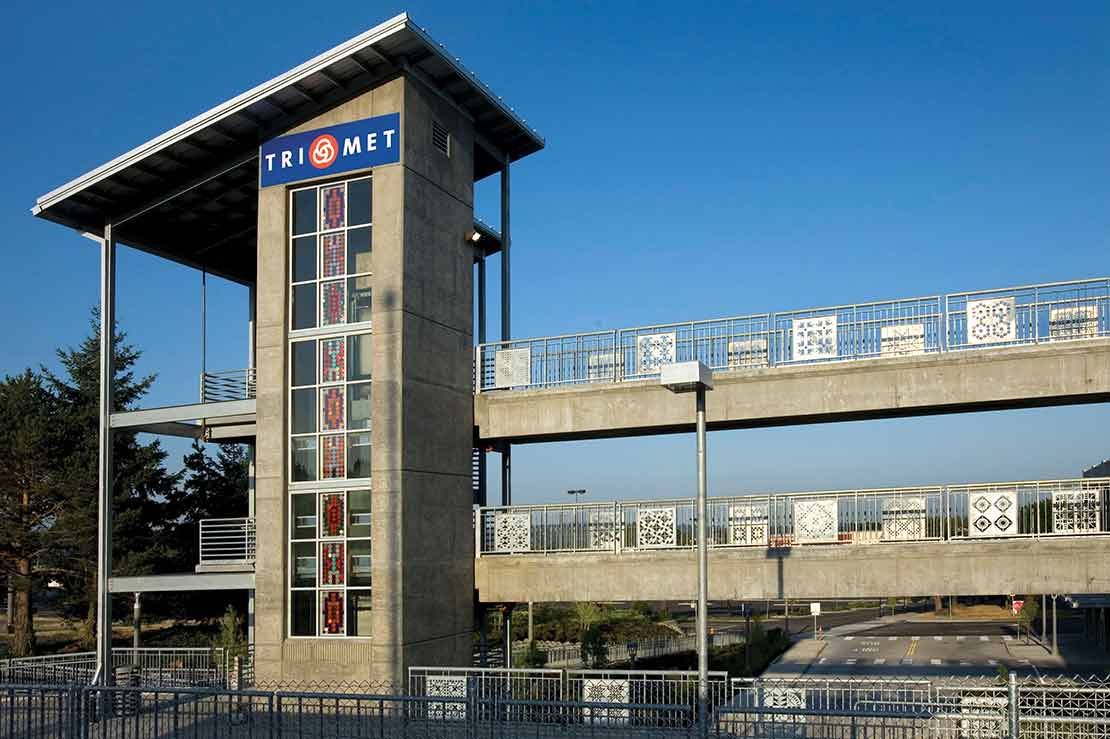 Clackamas Town Center Transit Center
Clackamas Town Center Transit Center
“ The Chain of Life by Richard Elliot combines elements of primal symbolism with modern technology. Rectangles, stars, diamonds and waveforms are images used by cultures throughout the ages to describe the workings of the cosmos. Symbols speak to a deep understanding of the inner-connectedness of all things.
The first link in this chain is on the station platforms. Brick pavers express a design inspired by the complex patterns of native Clackamas basketry.
The next link in time honors Oregon’s pioneer quilt makers. The artist’s long-time study and appreciation of quilts inspired the cut steel designs on the guardrail panels.
Elliot’s Twisted Ribbon, a twenty-eight-foot-tall artwork installed in the windows of the elevator facing Clackamas Town Center, is the contemporary link. Nine acrylic panels faced with two layers of multi-colored reflectors suggest a ribbon-like pattern of DNA. The brilliant light reflected from Twisted Ribbon creates an energy that connects the body and spirit.”
